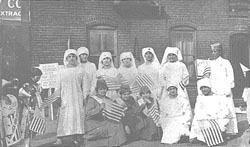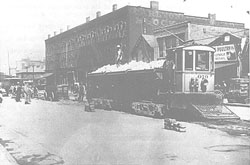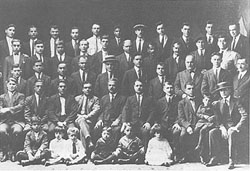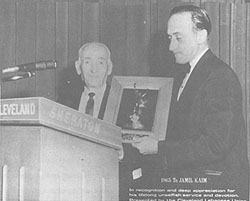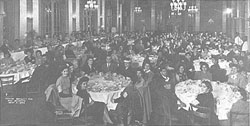|
CHAPTER 15 During the year-and-a-half of America's involvement in World War I, the Syrian-Lebanese shared an experience that was far different from any they had encountered in their own land. Centuries of domination by the Ottoman Turks had suppressed for most any stirring of nationalism they might have felt. Conscription into the Turkish army was not for the purpose of defending their own country but to preserve the strength and power of the Turks and their Empire. Why should they do this? Better get to America as fast as possible. Here it was different. Here they could belong to this country, and this country to them as soon as they could get their citizenship papers. Numbers of Cleveland Syrians went into the army while still aliens with a committment that they would then get their citizenship. They had something to fight for. Too, a new sense of pride was rising among them as news filtered over that the Arabs in the Middle East were blowing up all the railroads from Medina to Jerusalem, thus breaking Turkish communi�cations and turning the tides of war in favor of the Allies in that theater. Colonel Lawrence,54 Prince Feisal and the leaders of a dozen tribes were becoming as well known as General Allenby, General Pershing, and Woodrow Wilson. The Syrian-Lebanese now had their heroes on both sides of the water.
Everyone followed the war news avidly. The Lusitania was a name that evoked grief and anger. "Lady Liberty" was a symbol of patriotism and pride. The Kaiser and the Boche were the enemy. Turkey was the arch enemy and the news of each victory over her was received with joy. The heroism of the desert chieftains restored a lost dignity. For the Cleveland Arabs, World War I was a uniquely personal war. Their men were fighting in the American Army, and their compatriots of the old countries were playing a vital role in the Allied victories. During the War, the flu epidemic took its toll in the Cleveland community, and the pain was compounded by the knowledge that relatives back home in the old country were suffering not only from influenza but famine as well. Families went to each other's aid and took turns nursing the sick. Henry George, whose orchestra and Cabin Club were for many years a highlight of the Cleveland entertainment circuit recalls the flu epidemic on Bolivar Road. "Our house was like a field hospital. My mother, Admah George, had cots set up in double rows, along the length of each room, and I remember the smell of medicine, ointments and disinfectants, mixing with the steam from boiling kettles on the stove. The flu was highly contagious, but she had enough faith to insist she wouldn't get sick because so many people needed her. She just kept going, sleeping in her clothing and moving from cot to cot, checking the patients through the night. I guess she was right, for she didn't get sick, she just didn't have the time."
It was a year of Liberty Bonds, high prices, and shortages of foods that were sent to the Front instead. Coffee and sugar, two necessities in the Arab household were sorely missed. No one blamed Woodrow Wilson, who was the hero of the hour, and many a grandmother drinking tea, or a mixture of chicory, would add his name in her prayers as she asked a blessing for the sick in America, the hungry in the old country, and the good "Malek" (King) Wilson who had everyone to worry about. When church bells and factory whistles hailed the Armistice of November 11, 1918, the Arabs in Cleveland rushed out and joined the happy frenzy in the streets. Birth records for that year show a few Woodrows recorded. Two other names broke a record for popularity, joining the ranks of the Somia's, Alexanders, Abraham's and Mariam's permanently. "Victor" and "Victoria," were now an integral part of the Arab-American nomenclature. Horrifying stories of the war's aftermath began to reach Cleveland from the Lebanon and other parts of the Middle East. Starvation had struck all the familiar villages, hamlets and hills, and thousands had died. Each letter set off days of mourning. The names of the beloved relatives, dead or sickened, were upon the lips of every daughter and sister, brother and son throughout the Arab homes of Cleveland. With the horror and shock came a renewed determination to bring to this land of health and safety the survivors of the dead brothers and sisters, and families set themselves to this task with vigor. The following years, until the Quota Act of 1924 put an end to the hopes of thousands, more thousands of Syrians and Lebanese came into the United
Syrian Women's Red Cross Auxiliary at Bradley Court Bolivar Road, Cleveland, Ohio -- 1919 Street Railway Repair Crew directly in front of old Anter Bros. Wholesale Distributors established in 1912. Picture circa 1920.
States. Hundreds reached Cleveland and were reunited with relatives from whom they had been long separated. The boom of the 1920's not only touched the lives of the Syrians and Lebanese, among them some of the newest of immigrants, but uplifted them upon a wave of prosperity that took them to new heights. They invested in real estate, and some, like their American counterparts, plunged into the stock market. The old "kashi" peddler pack, sewer and street work job of the early years gave way to the wholesale house, construction company, garage and automobile shop, fine restaurant or import business. Some of the younger men attended business colleges and studied manage�ment and accounting so that the family businesses could be operated in a more efficient manner. Sometimes one would be heard to mutter, "I'm working on the adding machine, and the old man is still running it up in his head and on his fingers, and dammit he always comes out right, and beats me to it." The doors of medical or law schools were opening to more young men, and young women were insisting on their rights to go on to college. Some broke down parental resistance, and eventually family attitudes changed from doubt to pride in the daughters' accomplishments. Other young women went into business, setting up dress shops and import stores, or found jobs as secretaries. The liberation of Arab-American women was now keeping pace with that of their American sisters. One young woman, age 20, took Fred Kohler, one of Cleveland's toughest Mayors, to court over a piece of rental property. She won her case, kept her property and set about developing it into a good investment. Her name was
Julia Macron and she won success even though, like most of her generation, her education never reached high school level. The Arab-Americans of the Roaring Twenties were beginning to inter�marry with other nationalities and fast assimilating into the mainstream of American life. The Wall Street crash and the great Depression which followed affected many of the small businesses which had begun so optimistically. For some, the gains made in the years of plenty were wiped out in a matter of hours. Students quit school and took jobs; families joined forces to regain their losses, and Cleveland's Arab-Americans like everyone else in America tightened their belts and added more water to the "shawraba." Around the big kitchen table they would spend their evenings listening to Jake and Lena, while they strung manufacturers' tags or assembled small parts in piece work jobs at home. The Depression notwithstanding, they continued in their goals of assimilation. They organized cultural and political groups, aided in the Americanization of their more recently arrived friends and relatives, and joined civic groups which were not totally ethnic in their composition. The 1930's was a decade of growth and social development for the Arab-American community in Cleveland. The long struggle to overcome language barriers, cultural differences, and social and political discrimination was beginning to bear fruit. Bolivar Road had faded into nostalgic memory as families followed the patterns of urban migration and moved further and further away from the central city to both east and west suburbs. Acculturation and the efforts
toward assimilation brought the Arab Americans into ever closer proximity to the broad community. Like immigrant families of other nationalities, their life styles and customs did not completely merge into that of the Anglo-Saxon mainstream but rather, flowed parallel in a comfortable side by side channel of watchful acceptance. Politicians of both the Democratic and Republican parties, always on the lockout for re-enforcements, went among the Arab-American leadership and offered greater political involvement in the government of the Republic, an exciting prospect and challenge which brought promises of employment and prestige. Some of the Arab-Americans who were approached lacked formal education. Some, on the other hand, were better educated than many of the native Americans in the wards where they attended meetings. All, however, shared a common goal -- an insatiable desire to make it good in America, and a pioneer spirit to achieve that ambition. Moreover, they were not yet a generation disenchanted with the American dream. For them the flag, the national anthem, the Pledge of Allegiance were the staff and watchword of the convert's zeal, and they flung themselves with the energy and enthusiasm of the missionary to bring their landsmen into the privileged American activ�ity of political involvement. Among such leaders was a man whose love affair with America began during World War I when he served with the American Red Cross in Zahle, Lebanon. His mother was of mixed parentage. Her name was Louise Hurley. She was the child of a German father who was a political refugee from the Austro-Hungarian Empire, and of a Syrian mother. Jamil Kaim was the second youngest of six children born to Louise and Shaheen Kaim in 1892. Jamil�s
|
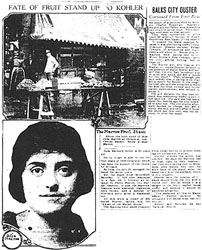 Cleveland newspaper story on Julia Macron and her battle with the city. | 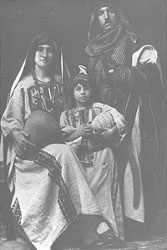 Jamil Kaim's parents. |
|
birthplace was the town of Aiteneet, in the fertile Bekaa Valley of Lebanon. Shaheen and Louise Kaim sent the boy to primary school in Aiteneet. Ambitious for the best education they could provide for him, they then enrolled him in the American High School in Shweir, and from there he entered the American University of Beirut. Prior to World War I, he had worked for the Sudan Railway, and from 1918 to 1920, served with the American Red Cross in the reconstruction and rehabilitation of the Lebanon. Jamil Kaim, pursuing the love for America which had begun in his native land long before, came to the United States in 1920. Upon his arrival in Cleveland, he went into business and then threw himself into the activities of the Arab American community. He was elected president of St. Elias' Church Council in 1922 and held that office periodically over a span of more than forty years. He was a joiner, organizer, and innovator, and in 1930 he gathered a number of his countrymen together to form one of the first Syrian Lebanese Democratic Clubs in the United States. With a salutation of "Dear Compatriot" a letter was circulated to the entire Syrian Lebanese community inviting them to meet on a Sunday in September at 1400 East 55th Street to join the efforts of the Aiteneet Brotherhood Association to "secure recognition from the Democratic Family." Since the Aiteneet Brotherhood which he had organized the year before had been able to get some results within a year, reasoned the foresighted
Jamil, it would be advantageous to unite as many of his "compatriots" as possible in the entire Arabic community in a common goal. "Let us stand firm with our mutual thoughts for a better world, and better conditions for our people," wrote Jamil Kaim. "Let us work together so that our ultimate goals and ambitions will be a shining example for all others to follow." The Aiteneet Brotherhood which was sometimes known as the Aiteneet Syrian American Democratic Club listed its first officers as James (Jamil) Kaim, James Abood, Ernest Sabath, Mufleh Nahra, George Bird (Asfour), Tom Abood, Nasif Shibley, George Rahal, Aziz Thomey, and Mabas Nahas. The Lebanon Syrian Democratic Club, which was organized following the letter to "Dear Compatriot," was active for many years and Jamil Kaim led it through several terms in office. Some of its other officers were James Abood, Dave Caraboolad, Elias Caraboolad, and Mary Amor Savolis, a high spirited individualist who was credited with many firsts among Cleveland Arab-American woman. Her marriage to a Greek was one of the earliest of the "mixed marriages." From the Twenties on, she had demanded equality of participation for women, and spear headed war drives, fund raising projects and relief efforts. Her leadership during the Lebanese Earthquake of 1956 was particularly memorable and her activities in numerous civic organizations set the tone for later generations to follow. Jamil Kaim did not trust a single language to communicate his messages. Campaign letters supporting candidates for public office always included an Arabic translation, and the favored candidate's name was always spelled out clearly in English in the middle of an Arabic sentence. Jamil, who was fast
becoming "Uncle Jimmy" to the younger generations, was meticulous and care�ful that everyone should get the message exactly right. Jamil Kaim firmly believed in reaching as many of his compatriots as was possible, and in informing the broader American community about his people. For this, radio was the answer, and in 1930, he organized and directed the first Lebanese Radio Program, its goal to preserve the cultural heritage of the Syrian-Lebonese people. He had hundreds of friends throughout the city, in the business and political community particularly. He was a walking employment agency, his office in his pocket, names and telephone numbers on dozens of notes, as he found jobs for the many people who depended on him for help. Politics was a second nature to him and he continued in his work of founding Lebanese Syrian Democratic Clubs in Toledo, Akron and Canton. Appointed chairman of these various groups for the State of Ohio by President Franklin D. Roosevelt, Jamil Kaim plunged into his political and patriotic activities with the happy innocence of a boy on his first job, and the nationalistic fervor of an American zealot. World War II found him at the head of a Syrian-Lebanese "Help Win the War" effort. Representatives of all the Arabic speaking organizations in Cleveland were mobilized into a committee which raised funds for a fully equipped mobile canteen which they donated to the Red Cross. They continued to pledge donations for war relief for the next three years until the end of hostilities. "When the American Flag and our Motherland Flag is called to our attention," Jamil Kaim once wrote, "the blood through my veins sparkles
Gathering of Aiteneet men with some of their children. Cleveland, Ohio, Circa 1920. Jamil Kaim receives award from Cleveland Lebanese Union
with inspiration, since patriotism and brotherly love towards our country�men are my incentives. Since my youth I believed in them and have preached them to all my countrymen." These were the years of intense loyalties to those men who had a family history of leadership, or who had taken strong command in the earliest years of immigration. Some led by force of a charismatic and dynamic nature. Issues were not as important as personalities or the one-to-one relationship, a characteristic uniquely Semitic. Men like Jamil Kaim organized groups and held them together by the power of their own persuasive temperaments. They were men who were admired and respected because they had accomplished something, had gained success in business or politics in spite of the language and social barriers. They had broken through into the Masons, the Knights of Columbus and the Democratic and Republican parties. They owned businesses or had respectable professions and had won recognition not only from their own people but from the broad community as well. These were the men who came forward as leaders in the twenties and thirties and continued on to become the elders in the forty to fifty years following. They were the men, and the women too, whose funerals were solemnized by the presence of five, six, or seven priests and bishops in the sanctuary, and whose funeral corteges, a block long, often took a detour from the usual route to take the deceased for one last drive past the place of business he had built up over the years out of the first dollars saved and unbelievable physical endurance. It was only in retrospect that later generations came to realize the capabilities and worth of these, the truly brave ones -- the pioneers who had paved the road that others would follow.
During the Thirties, civic and cultural involvement became more intensified, and the Arabic speaking Americans joined in community theater, debate clubs, and nationalities' festivals. They participated in the planning of the Cleveland Cultural Gardens, joined unions and civic assoc�iations. The International Institute, forerunner of today's Nationalities Services Center, was instrumental in assisting two young women's groups to organize. These were the Syrian Junior League and the Capricornians, their younger sisters. The name of the Junior League evolved after weeks of debate and soul searching for a suitable title. Some opted for Zenobia, in honor of Syria's warrior queen, and some thought Subaiyah would do well. However, Zenobia smacked of too much attachment to ancient Syria, and did not seem right for an American group, and Subaiyah could not be adequately trans�lated, since the word lay somewhere along the meaning of "young ladies," "jeune Filles" or "marriageable virgins." The name "Syrian Junior League" was changed in the mid 40's. The Cleveland Junior League, an earlier organization was concerned that two Junior Leagues might cause some confusion in the community. Since Lebanon had declared its independence in 1943, the opportunity was ripe to include the name of that state, and the Syrian Junior League became the Lebanese-Syrian Junior Women's League. From its beginning, the Syrian Junior League, under the guidance and gentle "nagging" of Miss Margaret Fergusson, executive secretary at the International Institute, plunged into educational and welfare projects,
Honor banquet for Miss Bayouth of the Lebanese Y.W.C.A. --
activities which remain the major function of the organization today, now in its fiftieth year. Christmas and Easter dances, outings on the Goodtime and the Aquarama, plays, card parties, bazaars, annual country club dinner dances, were all planned for the purpose of raising funds for children's institutions over�seas, scholarships for Cleveland students of Syrian-Lebanese descent, and donations to welfare agencies in Cleveland. When the campaign for a mobile canteen was launched during World War II the Syrian Junior League was one of the most enthusiastic and successful of the groups collecting donations. In its early years the association with the International Institute gave the organization a stability that enabled it to establish a sturdy base and broadened scope, bringing its members into close relationship with other nationality groups also headquartered at the Institute. The annual "Hanging of the Greens" was an evening of Christmas festiv�ity in which conviviality, nationalism, a happy competitive spirit, music, dancing and good food were mixed together in happy human companionship. The winding stairways and mahogany bannisters, fireplaces and mantles, sparkling leaded windows, and crystal and brass chandeliers of the old mansion that housed the Institute, were ornamented with green boughs, scarlet velvet, and Christmas tokens of many nationalities. As Linda George Anter, a charter member of the League says: "We had everything there. There were German cookies, and Swedish straw ornaments, and all kinds of nationality things. Pictures, dolls, bells on the trees, candles and lights everywhere. We all shared Christmas together. We |
